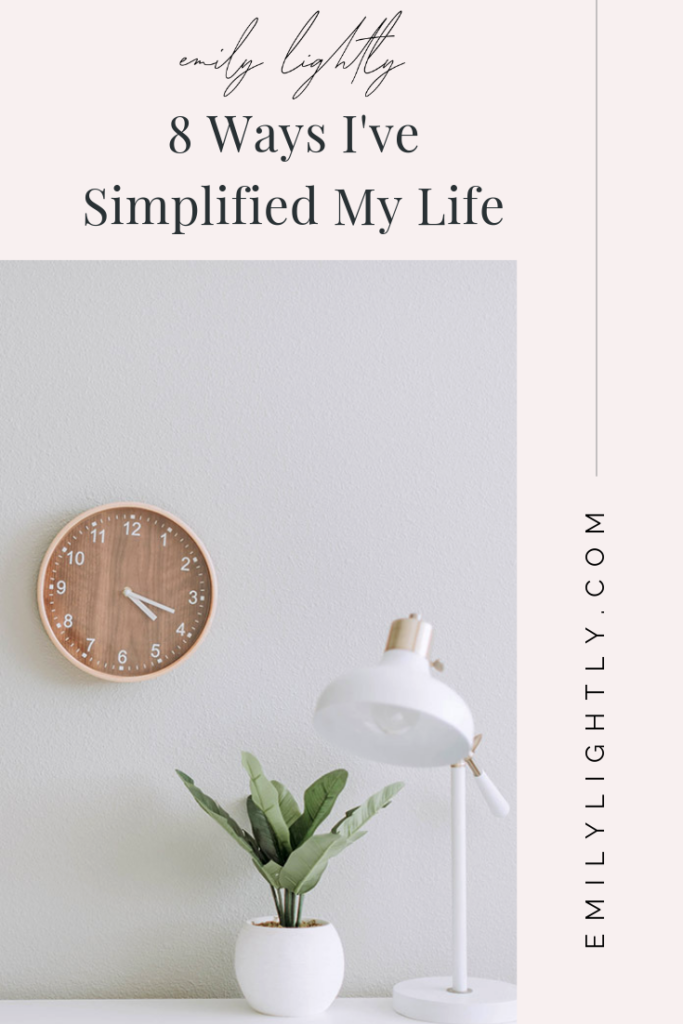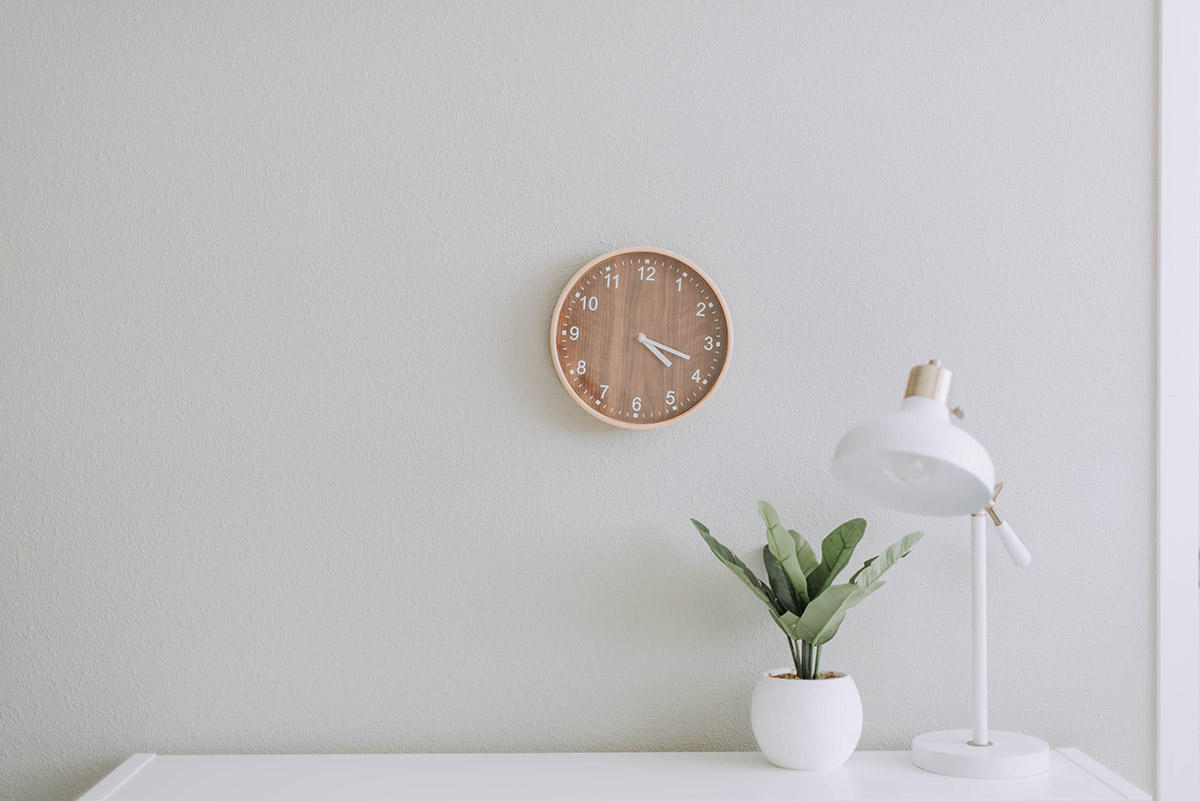We talk a lot about living a simpler life in a very idealistic sort of way. But what does it actually mean to live more simply, and what actions can you take to simplify your life? In today’s article I’ll be sharing 8 changes that I’ve made in my own life to simplify, slow down, and reduce my environmental footprint. So if you’re looking for some ideas on how you can actually simplify your life, this article is for you!
1. Decluttering and Minimizing Possessions
You knew this one was coming! The main thing that’s helped me live a simpler life is reducing the number of things I own. It all started with my closet; I got rid of more than half of my clothes, shoes, and accessories and moved over to a seasonal capsule wardrobe where I purchase only a few things per season and wear mostly what I already have.
After my closet, the decluttering bug had got me, and I worked on selling and donating a lot of what I owned – books, kitchen items, furniture, decorations, games, etc. Having less clutter around the house really makes me feel a lot calmer and less stressed, and I’m better able to focus on and prioritize those things in my life that I hung onto that are truly important to me.
2. Shopping Less
Once I’d decluttered everything, the last thing I wanted to do was go out and buy more stuff. It was like a cleanse, and I never wanted to go back to where I was before – spending so much money on things I didn’t really need, letting things go to waste, and still feeling unfulfilled.
I started really thinking carefully about my purchases. I started a wish list to hang onto things I wanted and see if I still wanted them in a while. This helped me reduce my impulse shopping, and I spend way less money on things than I used to. I also started trying to feel more grateful for what I have, and that contentedness made shopping much less tempting. I still buy things, but I focus more on necessities or things that I’ve wanted for a long time and have considered very carefully.
Reducing consumption is also a great way we can single-handedly combat waste and decrease our carbon footprint. When you combine it with the benefits of saving money and dealing with less stress and clutter, it’s no wonder the minimalism movement is gaining so much traction these days.
3. Budgeting
Something that also helped me spend less money was starting a personal budget to keep track of my income and expenses. I was so tired of working so hard and feeling like I had nothing to show for it – my savings account was pretty pitiful, and I felt so ashamed for spending all of my money on things I didn’t need or truly want.
Keeping track of my expenses on a budget really helped me see where my money was going and how much I was spending on different areas of my life. I set monthly limits on different categories, and as I watched them fill up it would help me re-prioritize or alert me to where I was spending too much. I was able to start building savings for things like emergencies and travel. All of this just helped me slow down and kind of put the brakes on all of the things that were cluttering up my life and making it more complicated beforehand.
You can download my personal budget template which is the one I actually use for free here!
4. Changing Small Habits
We have a lot of habitual behaviours that are deeply ingrained in us and thus hard to change. One of those for me was buying books. I love reading and always have, and I just loved the feeling of walking into a bookstore, picking up a new cosy read and taking it home for my bookshelf. The problem was, sometimes I never even read them. It was a bad habit of mine; so I looked for an alternative and changed that habit. I stopped buying books, and instead now I take them out from the local library. It has saved me so much money, reduces waste, and keeps my bookshelf uncluttered. Plus, I actually read the books because I know I only have them for a limited time – so it’s a total win-win!
Changing small habits like this one at a time is a lot easier than trying to simplify your life all at once. There are a lot of low-waste, budget-friendly alternatives out there to the way we habitually consume – you just have to find them and then make the effort to switch your habit over.
5. Saying No
I was born and bred a people pleaser, and to some extent I still am – I’m not sure if I’ll ever kick that habit! In some ways it’s not a bad thing, but it can be very detrimental if you’re giving too much of yourself away too often. I realized that I was saying ‘yes’ to things too often just because I thought I should, or that it was expected of me. But then I realized it’s my decision, and I could be a lot happier (and a lot less busy) if I started saying ‘no’ to those things that weren’t truly important to me.
Keeping your schedule clear and having fewer obligations is a really great way to keep your life simple and really slow down. Take a critical look at your daily, weekly, and monthly activities, and see if there’s anything in there that really isn’t serving you or that you could live without. Make a list of priorities and see what comes out on top versus what comes out on the bottom, and consider what you could let go of in order to have more focus and calm in your life.
6. Simple Eating
Cooking at home was never something I wanted to do when my life was busy and cluttered. I’d spend money on my morning caffeine to keep me going, and buy takeout because I was too stressed or tired to make food myself. Once things started to slow down and I had a little more time, I moved to cooking more home-based meals, and I realized it’s actually not that much work. You can choose how much effort you want to put into it – you can either make really fancy and complicated recipes, or you can make simpler food that still tastes good and keeps you going, but that’s easier to make.
A great way to do this is to do meal planning. Once a week, set aside a few hours to pre-make some meals ahead of time. Keep them in the fridge or freezer and eat them throughout the week. It reduces the amount of daily time you spend cooking, and if you get really good at just a handful of recipes, it’s a lot simpler than trying to find something new to make every day. It also saves food waste since you plan and prep all of your groceries and meals ahead of time instead of buying sporadically throughout the week and ending up with unused ingredients or leftovers. Cooking at home more saves money and time in the long run.
Another change I’ve made is to switch to a mostly plant-based diet. This is a personal choice, and I have a few reasons for it. One of those is because it reduces my carbon footprint. It also makes it a lot easier for me to eat healthy and saves money, since eating meat is expensive. I even grow some of my own food in my garden, like herbs and veggies. Not having to buy these from the store reduces transportation pollution and packaging waste. Other tips I have would be to eat local, in-season produce when possible, and buy as much zero-waste or bulk as you can as opposed to packaged food.
Simply + Fiercely wrote a great article on simple eating if you’d like to read more! I also love Minimalist Baker for her super simple and delicious recipes.
7. Active Transportation
Walking or cycling instead of driving is a great way to reduce your environmental footprint while also getting some much-needed fresh air and exercise. I started walking to and from work, which is about a 35-minute walk one way. It’s great for me because I get some exercise in (kill two birds with one stone), and I also love starting my day with a nice walk and maybe some music or a podcast. You can make a bit of a meditation out of it and just enjoy being outdoors and in nature. It’s a great way to slow down while also getting the added benefits of exercise and less pollution.
8. Exercising at Home
Lastly, and still on the topic of exercise, I started doing home-based workouts instead of going to the gym or to a class. There are so many free resources out there on YouTube (I made a list of some good ones here to start with). There’s no need to spend a lot of money on an expensive gym membership that doesn’t really get used because your life is already too hectic to also factor in a trip there and back. All you need is a mat and maybe a set of weights, but that’s not even necessary – there are plenty of options out there that use body-weight only exercises and still give you a great workout. Taking out the complication of a gym membership really helped encourage me to actually work out and take it at my own pace, while also saving money.
I hope you found this article helpful and interesting! Let me know how you’ve simplified or plan to simplify your own life in the comments below. Thank you for reading!

Pin for Later

Featured photo by Samantha Gades on Unsplash


Emily! Great article as always. You help and inspire me through my own minimalist journey. You’re one of the first simple living bloggers I found when starting this process. Never written, but thought it was time to say hi 🙂
Hi! Thank you, that means so much to me.
I love this post because all the items resonate with me and I do basically all of them!
In number 2, I notice that since I rarely buy new things, I really cherish them when I buy. As for supermarkets, I do two things there: I make a list of what I want and I only shop after I’ve eaten. That way I only buy what I need and nothing more, impulsively.
In number 4, I also buy a lot of books that I don’t read. So whenever I feel like buying another book, I made a deal with myself: I need to first finish reading everything I have already bought. If there’s a book I bought and I don’t wanna read anymore, I have to either donate or sell it. I only keep books that I want to read again or read the notes.
I’m practicing number 6 because of Covid-19! I have always been too lazy, but all your suggestions make perfect sense and I see all the benefits you mentioned. I am also experiencing something I wasn’t expecting: my digestive system is much better than before. I suspect that it’s because I’m including a variety of vegetables in the meal plan, and because in home-cooking one can assure the hygienic care. As much as you “trust” a restaurant, you never reaaaaally know what’s going on back there.
As for number 7, that was also great when I visited cities. I visited Seattle last year and it was my first time ever in the United States. I didn’t really know how transportation worked, so I decided to walk everywhere instead because I wanted to take in the small details we see in movies, like “alleys” between buildings or the suburban housing neighbourhoods with cul-de-sacs, etc. It was great because I felt like a local after walking for about 2 hours everyday, 7 days in a row.
When I visited London, I used the bike system with a cousin who is from the UK and has lived in London for years. It was the first time he tried that too and said he never experienced London that way. Suddenly the impersonal distances we see only through the Tube map are given a physical look, a physical connection and things seemed closer than what we perceive from a metro-diagram.
The ONLY thing I cannot fully do is number 8 because I have scoliosis so my doctors told me I need to “eternally” swim as my main (and preferably only) sport. That means I really need to subscribe to a complex with a pool.
Thanks a lot for the great list!